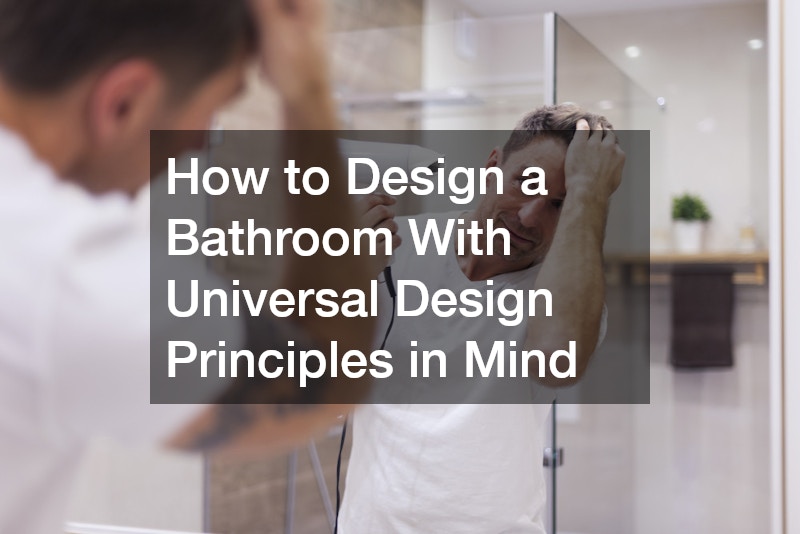
How to Design a Bathroom With Universal Design Principles in Mind
Creating a bathroom that caters to everyone—regardless of age, ability, or mobility—requires an understanding of universal design principles. These principles focus on creating spaces that are accessible and functional for all users, ensuring safety and comfort without compromising style. When designing a bathroom, incorporating universal design features can improve usability and promote independence for everyone. Here’s a guide to help you understand the essential elements of universal bathroom design.
1. Emphasize Accessibility
Accessibility is a crucial element of universal design. When planning your bathroom, consider the following features:
Wide Doorways:
Keep in mind that doorways should be at least 32 inches wide to accommodate wheelchairs and walkers. This design choice allows for easy navigation in and out of the bathroom.
Curbless Showers:
A curbless shower eliminates the barrier of a raised threshold, making it easier for individuals with mobility challenges to enter and exit safely. Use slip-resistant tiles to reduce the risk of falls.
Grab Bars:
Install sturdy grab bars near the toilet, shower, and bathtub. These bars provide essential support for individuals who may need assistance while standing or sitting. Select grab bars that blend with your bathroom’s decor for a seamless look.
2. Optimize Space Layout
The layout of your bathroom can significantly affect its usability. Aim for a design that maximizes space and allows for smooth traffic flow. Consider the following:
Clear Pathways:
Design pathways that are at least 36 inches wide to accommodate movement for individuals using mobility aids. This ensures that everyone can access essential areas without obstruction.
Accessible Fixtures:
Place sinks, toilets, and other fixtures at appropriate heights. Standard sink height should be around 30-34 inches for wheelchair users, while toilets should be 17-19 inches high to facilitate ease of use. Experienced bathroom fitters can install these fixtures correctly for optimal accessibility.
Flexible Storage Solutions:
Use open shelving or pull-out drawers that are easy to access. Storage should be within reach for all users, including those seated. Avoid high cabinets that require stretching or climbing.
3. Prioritize Safety
Safety should be at the forefront of your design considerations. Here are several ways to enhance safety in the bathroom:
Non-Slip Flooring:
Choose materials with a high slip resistance rating to prevent falls, particularly when the floor is wet. Textured tiles or vinyl can offer both safety and style.
Adequate Lighting:
Make sure that your bathroom is well-lit, with a combination of ambient, task, and accent lighting. Consider motion-sensor lights for hands-free operation, especially in areas like the shower or toilet.
Easy-to-Use Faucets:
Install lever-style faucets, which are easier to operate for individuals with limited hand strength. Consider touchless faucets that allow for hygienic, hands-free use.
4. Focus on Comfort
Comfort in the bathroom enhances the overall experience for all users. Here are some elements to consider:
Temperature Control:
Install thermostatic valves in the shower to maintain a consistent water temperature, preventing sudden temperature changes that could cause discomfort or burns.
Adjustable Showerheads:
Use a handheld showerhead with a slide bar that allows users to adjust the height according to their needs. This feature benefits individuals of all heights and abilities.
Comfortable Seating:
Incorporate a built-in bench in the shower or a fold-down seat to provide a safe and comfortable place for users to rest while showering. This feature is particularly beneficial for seniors and those with mobility challenges.
5. Personalize Aesthetics
While universal design focuses on functionality and accessibility, it’s important to maintain aesthetic appeal. Personalizing your bathroom design can make it feel warm and inviting. Here’s how to achieve that:
Choose a Neutral Palette:
Opt for a neutral color palette that creates a calm atmosphere. Incorporate colorful accessories or artwork to add personality without compromising the overall design.
Incorporate Natural Light:
Use windows, skylights, or light tubes to bring in natural light, making the space feel larger and more inviting. Natural light also enhances visibility, promoting safety.
Stylish Finishes:
Select finishes and fixtures that reflect your style. There are countless options available that combine accessibility with modern design, from sleek grab bars to elegant faucets.
6. Engage in Inclusive Design
Incorporating feedback from users is crucial to creating a truly universal bathroom. Engaging with family members or friends who have diverse needs can provide valuable insights into functional elements that work best for everyone. Consider hosting a design brainstorming session where ideas can be shared openly.
Final Thoughts
Designing a bathroom with universal design principles requires thoughtful planning and a commitment to inclusivity. By focusing on accessibility, safety, comfort, and aesthetics, you can create a functional space that caters to the needs of all users. Incorporating these principles not only enhances the usability of the bathroom but also promotes independence and boosts confidence, ensuring that your space remains a sanctuary for years to come. Stick to the principles of universal design and transform your bathroom into a space that truly welcomes all.
.




